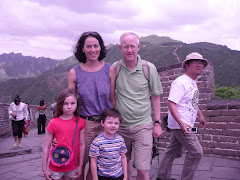Some families have big adventures on vacation - climbing mountains, floating down rivers, eating exotic foods.
The New Yorker's recent food issue included a story about a couple that met in Tibet and traveled the world in search of amazing recipes, even with their young children.
We are not like that - so far. One couple I know in Seattle prepared their children for serious travel by having them nap in different places every day. We're just glad when our children go to sleep in their hotel beds, though travel is definitely getting easier for us; when Blaine was paying his bribe at the Bali airport, both kids were very patient even though they were exhausted.
Having said that, we booked ourselves into the Westin because it has a "kids' club" to give us a break on childcare and of course spent more time at the resort than on adventurous tours of Bali.
We saw the flipside of our equation when we crossed paths with our friends Rena Singer and John Murphy (of the Wall St. Journal). They stayed at a villa, as it's called, in Seminyak, a favorite Euro tourist town. Though obviously not a hardship post it was a stretch toward family independence, untethered from the Westin's unbelievable breakfast buffet.
Here's a picture of Rena and John's villa: big movable doors, open-air living spaces, a kitchen, a swimming pool, and frogs that hopped into the living room during a downpour.


Of course I immediately made an envious comparison between their arrangement and our hotel. Clearly, our vaca was more lame! Then I came to my senses: 1) Arno can't swim so the pool would be a hassle; 2) We enjoyed not cooking on vacation; 3) Without the Westin's kids' club, we'd go nuts.
But Rena and John, who lived in South Africa and Jerusalem before they came to Tokyo, did shake us out of our hotel stupor. They took us to Padang Beach, which is hidden behind an enormous cliff. You walk through a stone passageway to find this very calm beach. I thought it was neat that we were swimming in the Indian Ocean.


Then Rena and John's driver (we were in a taxi) took us to a restaurant on a cliff overlooking the ocean, with great views of the sunset.


We watched the surfers come up from the beach (they attach surfboards to motorcycles) and ate fried calamari and Indonesian fried noodles and beer, while the kids drank strawberry milk and watched lizards climb the walls.


We all had a great time.






























